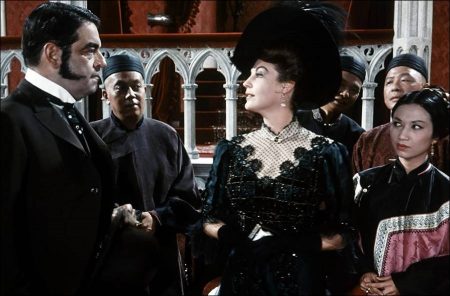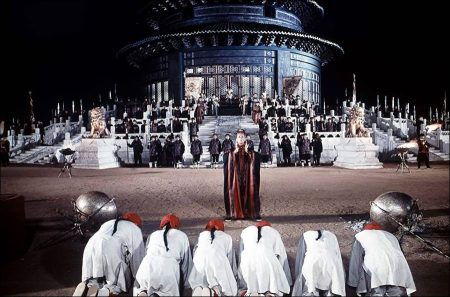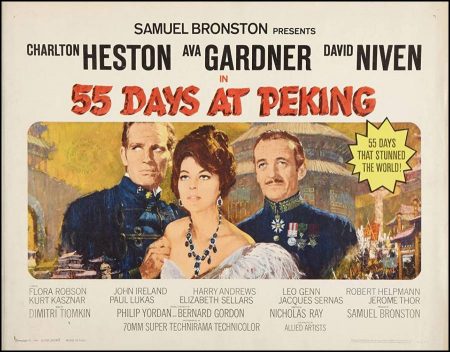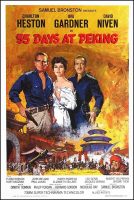55 Days at Peking movie storyline. During the 1899 to 1901 Boxer Rebellion, Peking is an open city with the Chinese, and several European countries vie for control. The Boxers, who oppose Christianity and the western powers, who still exercised complete sovereignty over their compounds and their citizens. The head of the U.S. garrison is Marine Major Matt Lewis (Charlton Heston), an experienced China hand who knows local conditions well. He meets exiled Russian Baroness Natalie Ivanoff (Ava Gardner), with whom he falls in love.
The political situation is tension-filled with the Boxers having the tacit approval of Dowager Empress Tzu-Hsi (Dame Flora Robson). When the Boxers attack the foreigners, Major Lewis, working with the senior officer from the British Embassy, Sir Arthur Robertson (David Niven), tries to keep them at bay pending the arrival of a relief force.
55 Days at Peking is a 1963 American epic historical war film dramatizing siege of the foreign legations’ compounds in Peking (now known as Beijing) during the Boxer Rebellion, which took place in China from 1898 to 1900. It is produced by Samuel Bronston for Allied Artists, with a screenplay by Philip Yordan and Bernard Gordon with uncredited contributions from Robert Hamer and Ben Barzman. Noel Gerson wrote a screenplay novelization, under the pseudonym Samuel Edwards, in 1963.
The film was directed primarily by Nicholas Ray, although Guy Green and Andrew Marton took over in the latter stages of filming after Ray had fallen ill. Both men were uncredited. It stars Charlton Heston, Ava Gardner, and David Niven, with supporting roles by Flora Robson, John Ireland, Leo Genn, Robert Helpmann. Harry Andrews, and Kurt Kasznar. It also contains the first known screen appearance of future martial arts film star Yuen Siu Tien. Japanese film director Juzo Itami, credited in the film as “Ichizo Itami”, appears as Col. Goro Shiba.
55 Days at Peking was released by Allied Artists on May 29, 1963 and received mixed reviews, mainly for its historical inaccuracies and lack of character development. However, the film was praised for its acting, direction, music, action sequences, and production design. In addition to its mixed critical reviews, the film grossed $10 million at the box office against a budget of only $10 million. Despite this, the film was nominated for two Academy Awards. It was director Ray’s last film until Lightning Over Water (1980).
About the Production
Principal photography began on July 2, 1962. The film was shot on location in Las Matas. Three thousand extras were required, including 1,500 Chinese. There were estimated to be 300 adult Chinese people in Spain so the rest were imported from all over Europe, particularly London, Rome, Marseilles, and Lisbon.
As production continued, Gardner was difficult during the shoot, often turning up late, disliking the script, and drinking heavily. One day, she walked off set claiming an extra had taking her photograph. Ultimately, the idea to write Gardner out of the film came from screenwriter Ben Barzman, who had rewrote El Cid. According to Heston, Yordan had written a death scene in which the Baroness dies of shrapnel wounds. By the time the scene was shot, Gardner struggled to remember her lines. Heston then suggested giving her lines to Paul Lukas, who was playing a physician.
On September 11, 1962, Ray was hospitalized after suffering a heart attack. At this point, production had fallen six weeks behind schedule with Gardner’s role being nearly complete, but significant scenes for Heston and Niven had yet to be shot. To replace him, Heston suggested Guy Green, who had previously directed him in Diamond Head (1963) to finish the remaining scenes between him and Gardner.
Green subsequently left production, and by October 1962, directorial duties were transferred to Andrew Marton, who was directing second unit. Marton reflected, “When I came onboard, I thought the picture was very shallow, just action, action, action – there was no meaning. I wrote a new beginning and a new ending and submitted them to management – who consisted of Bronston and Michael Wasynski… Anyway, they said ‘No’ with a capital N capital O. And I was very unhappy.” Regardless, Marton invited director John Ford onto the set to advise him on shooting the sequences. Heston finished his scenes on October 20, 1962, for which he wrote in his journal, “What I have learned from this, I hope permanently, is never start a film without a good finished script.” Principal photography ended on November 15, 1962.
55 Days at Peking (1963)
Directed by: Nicholas Ray
Starring: Charlton Heston, Ava Gardner, David Niven, Flora Robson, John Ireland, Leo Genn, Robert Helpmann, Kurt Kasznar, Paul Lukas, Elizabeth Sellars, Massimo Serato, Jacques Sernas
Screenplay by: Philip Yordan, Bernard Gordon
Production Design by: Veniero Colasanti, John Moore
Cinematography by: Jack Hildyard
Film Editing by: Robert Lawrence
Costume Design by: Veniero Colasanti, John Moore
Set Decoration by: Veniero Colasanti, John Moore
Music by: Dimitri Tiomkin
MPAA Rating: None.
Distributed by: Allied Artists
Release Date: May 29, 1963
Views: 419



